A product roadmap is the first step for any startup. It sets the direction by clarifying the vision and choosing the right features. Alongside resource planning, it connects user needs with market demand. With the rise of AI-driven product roadmap approaches, startups can leverage automation and predictive planning from the MVP stage onwards.
In this blog, we will walk you through a real-world product roadmap example from the insurance claims settlement space, explain how to build a step-by-step AI product roadmap, and share a reusable product roadmap template for startups that you can apply to your own idea.
To streamline this process further, many startups rely on product discovery software services to validate ideas and align product vision.
Problem Context: The Complexity of Insurance Claims
As discussed with one of the startup founders, they have highlighted a real pain point: insurance claim settlements are often complex, stressful, and time-consuming.
Whether it’s for:
- Health Insurance
- Life Insurance
- Term Insurance
- Accidental Insurance
- Motor Insurance Claims
- Loan protection policy Claims
- Overseas Travel Insurance Claims, etc.
Users often struggle with multiple forms, insurer coordination, documentation issues, and long wait times.
There’s a huge opportunity to simplify this process using AI roadmap planning tools and digital platforms powered by AI-driven intelligence, automation, and empathy.

Our Example Startup: ClaimSpark (Fictional)
Let’s imagine you're building a startup called ClaimSpark.
Your vision: “Expert Guidance for Your Stress-Free Insurance Claims Settlement.”
Here’s a product management roadmap example of how you might frame a naming prompt for such a product:
Suggest a unique and impactful name for a startup product focused on the insurance claim settlement domain. The name should reflect trust, efficiency, and expertise in handling rejected or delayed claims. Consider that in India, a competitor’s product is named ‘ClaimsNidan,’ which blends the word ‘claims’ with a culturally meaningful local term. Please suggest similarly creative and brandable names. However, the suggestions should remain original, regionally relevant (depending on culture, language, and emotional context), and carefully balanced to avoid IP conflicts or copyright issues..
Step-by-Step: Designing the Product Roadmap with AI
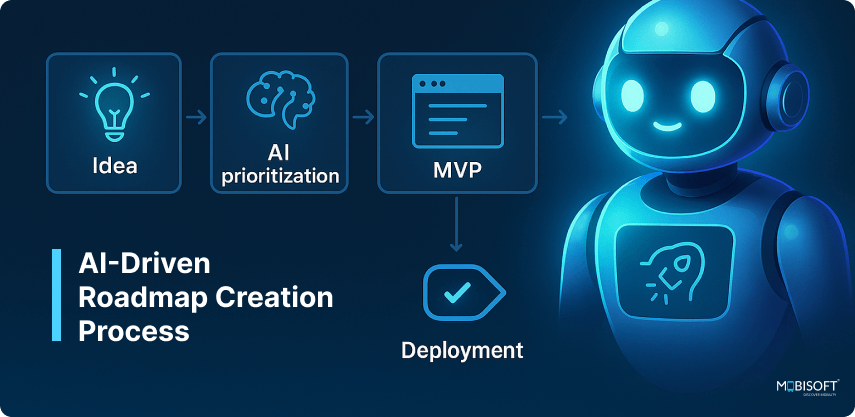
Step 1: Define the Vision and Product Goals
Vision: ClaimSpark believes insurance claims shouldn’t cause stress. The goal is to design an AI product management roadmap that clarifies, standardizes, and accelerates the process. By adopting product roadmap best practices, the platform fosters trust and delivers expert assistance to help settle claims on time.
Goals:
- Simplify the Claims Journey: Provide a seamless and intuitive platform that demystifies the complex insurance claim process with the help of AI product roadmap tools.
- Accelerate Settlements: Leverage expert intervention and smart workflows to reduce delays and fast-track claim approvals, following an agile product roadmap approach.
- Resolve Rejected Claims: Offer specialized guidance to help users understand, appeal, and recover denied claims with confidence through structured product development roadmap planning.
- Build Trust Through Expertise: Deliver reliable, step-by-step assistance from industry professionals to ensure every user feels informed and supported.
- Deliver a Stress-Free Experience: Minimize friction and frustration by combining technology with human empathy for a hassle-free settlement experience.
Prompt to help you define the Vision and Product Goals:
Provide a concise and compelling description of the Vision and Product Goals for my startup product "Claimspark", which focuses on the insurance claim settlement domain. The description should highlight how "Claimspark" aims to make the insurance claim process faster, simpler, and more user-friendly. Emphasize its core values of trust, efficiency, and expertise, particularly in resolving rejected or delayed claims. Mention that the platform offers expert guidance to help users achieve stress-free claim settlements.
To maximize efficiency, many teams now rely on AI project management tools that bring predictive insights and automation into planning.
Step 2: Identify Core Use Cases
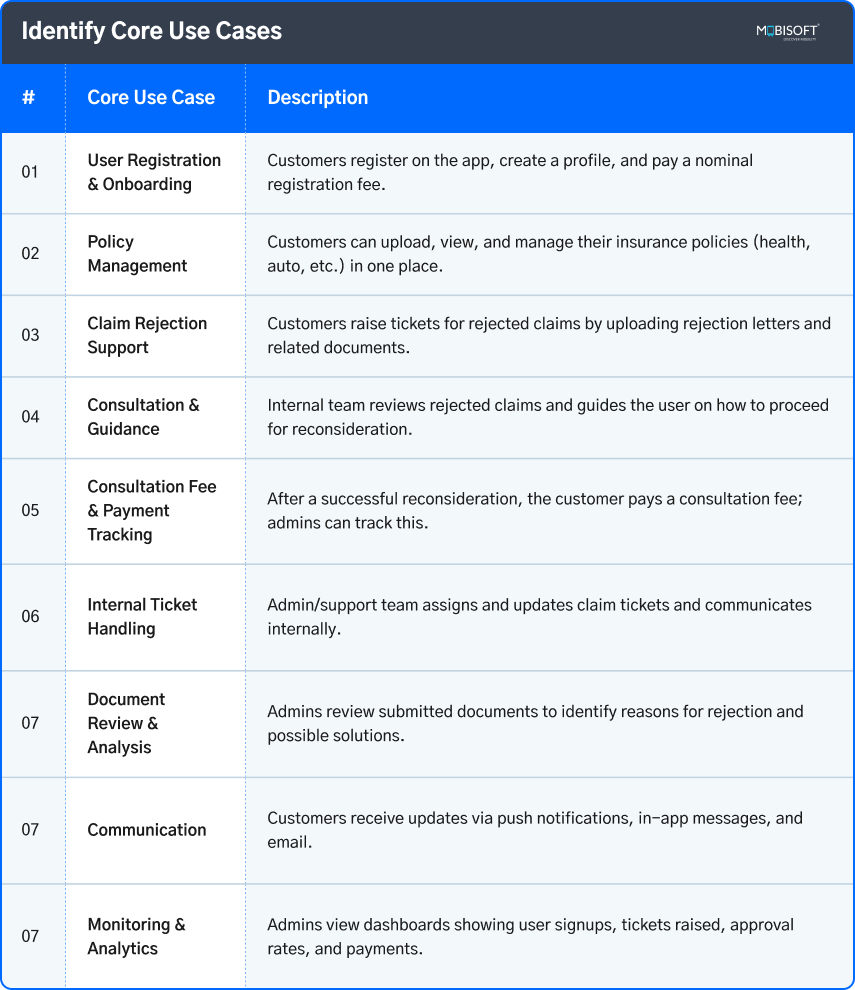
How AI Helps
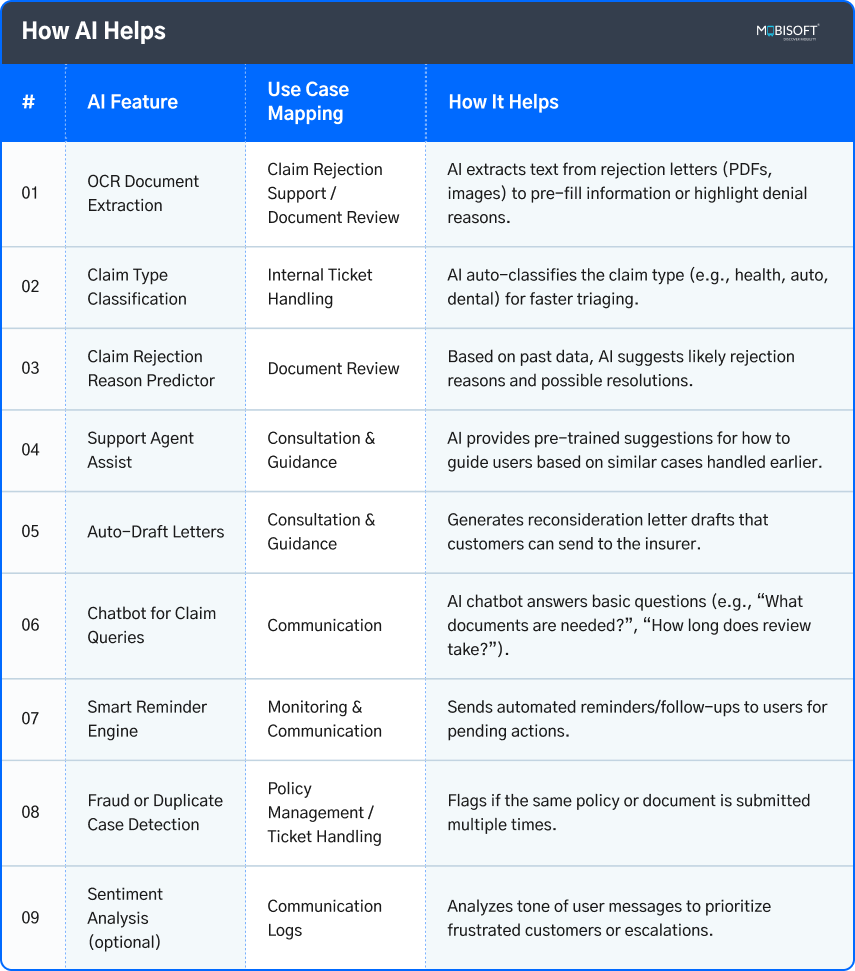
Prompt to Uncover Key Insurance Claim Use Cases and AI Enhancements:
Identify the core use cases in the insurance claim settlement domain and explain how AI can enhance each use case. Focus on how an AI product roadmap improves efficiency, accuracy, decision-making, and user experience throughout the claim lifecycle from document verification and fraud detection to claim approval and dispute resolution.
Such implementations also benefit from agile product lifecycle management practices to ensure iterative delivery and adaptability
Step 3: Identify Feature List
A. Mobile App (Customer Facing)
Onboarding & User Account
- User Registration (Email, Phone, OTP)
- User Login/Logout
- Profile Management
- KYC Upload (optional for premium support)
Payment System
- Registration Fee Payment (via Razorpay/Stripe/etc.)
- Payment History
- Consultation Fee Payment after Claim Reconsideration
Policy Management
- Add Insurance Policies (Health, Life, Auto, etc.)
- View/Manage Registered Policies
- Upload Policy Documents
Claim Support
- Raise a Ticket for Rejected Claim
- Upload Claim Rejection Letter & Related Documents
- View Ticket Status
- Chat/Message with Support Team
Notifications & Updates
- In-App Notifications
- SMS/Email Alerts for status updates
- Push Notifications (reminders, messages from support)
Others
- FAQ & Help Center
- Contact Support
- Rate our Service/Feedback
B. Admin Panel (Staff and CMS Users)
User Management
- View/Edit Registered Users
- Block/Activate User Accounts
- View Payment Status
Policy & Claim Ticket Management
- View Submitted Policies
- View/Raise Claim Tickets
- Assign Support Agent
- Internal Notes for Case
- Update Ticket Status (Pending, Under Review, Approved, Rejected, Escalated)
Payments & Invoicing
- View Payment Reports
- Mark Consultation Fee Payment Status
- Generate Invoice (PDF)
AI Support Tools
- AI Claim Triage (initial auto-classification)
- Document Text Extraction (OCR for PDFs)
- Smart Suggestions for Support Agents (Based on Similar Past Cases)
- MIAIChat Plugin for Standard Reply Suggestions
Admin Utilities
- Dashboard: Stats on Users, Claims, Payments
- Ticket History/Logs
- Notifications & Alerts
This shift is part of a larger wave of digital transformation in startups, changing the next era of innovation.
Step 4: Build the Product Roadmap
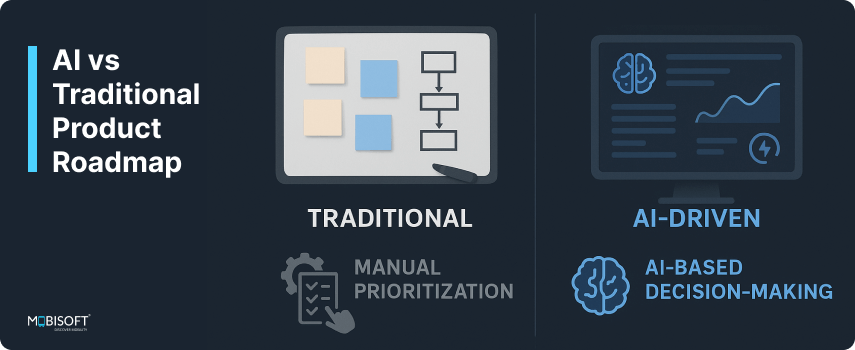
Break the roadmap into phases based on functionality, feasibility, and AI maturity.
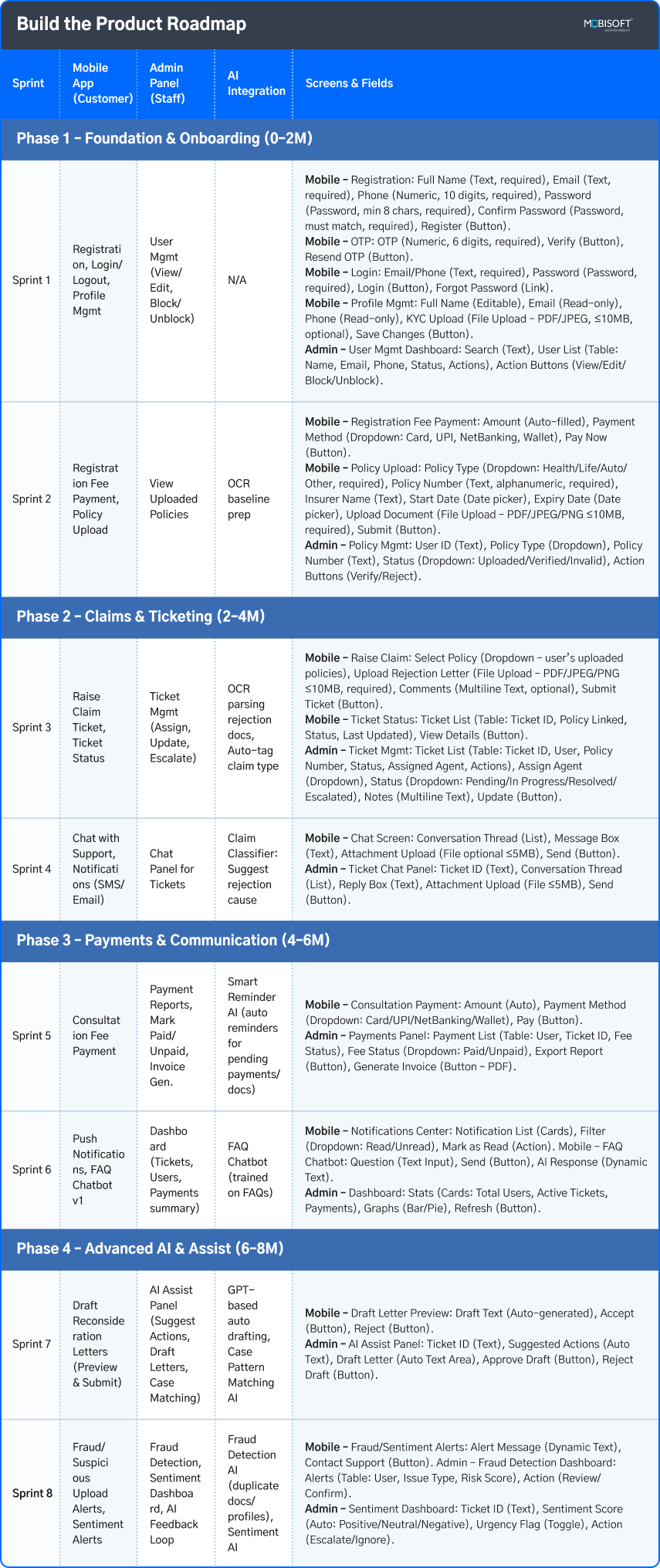
Optional Post-MVP Enhancements (Backlog)
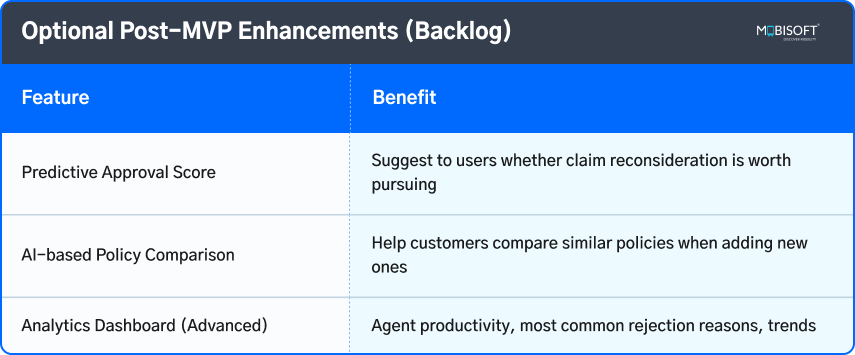
Use the following prompt and supporting note to generate the Feature List and Product Roadmap:
Provide a detailed feature list separately for both the Mobile App and Admin Panel for the following service-based platform:
Overview of the concept:
- Customers can register on the platform.
- Once the account is created, they can pay a nominal registration fee to access the services.
- They can register multiple insurance policies and raise support requests for rejected claims.
- Our team will assist them by reviewing the rejected claims and guiding them on how to proceed with reconsideration and approval.
- Once a claim is successfully reconsidered and approved, the customer is required to pay a consultation fee.
Use the feature list and create a comprehensive Roadmap. The roadmap should be broken into phases based on functionality, feasibility, and AI maturity.
For each Phase, define:
- Sprints
- Features/Tasks
- AI Integration opportunities
Additionally, include detailed screen-level documentation for each feature:
- Specify all screens required.
- For each screen, list UI fields, their types (text, dropdown, checkbox, etc.), and the number of fields.
- Include validation rules, error messages, and success messages.
The output should serve as an execution-ready roadmap with structured phases, sprint breakdowns, and complete UI/UX guidelines so that the project can be directly developed using this documentation.
If you're exploring the best way to get started, here’s a detailed guide on how to build an MVP
Step 5: Define KPIs and AI Metrics
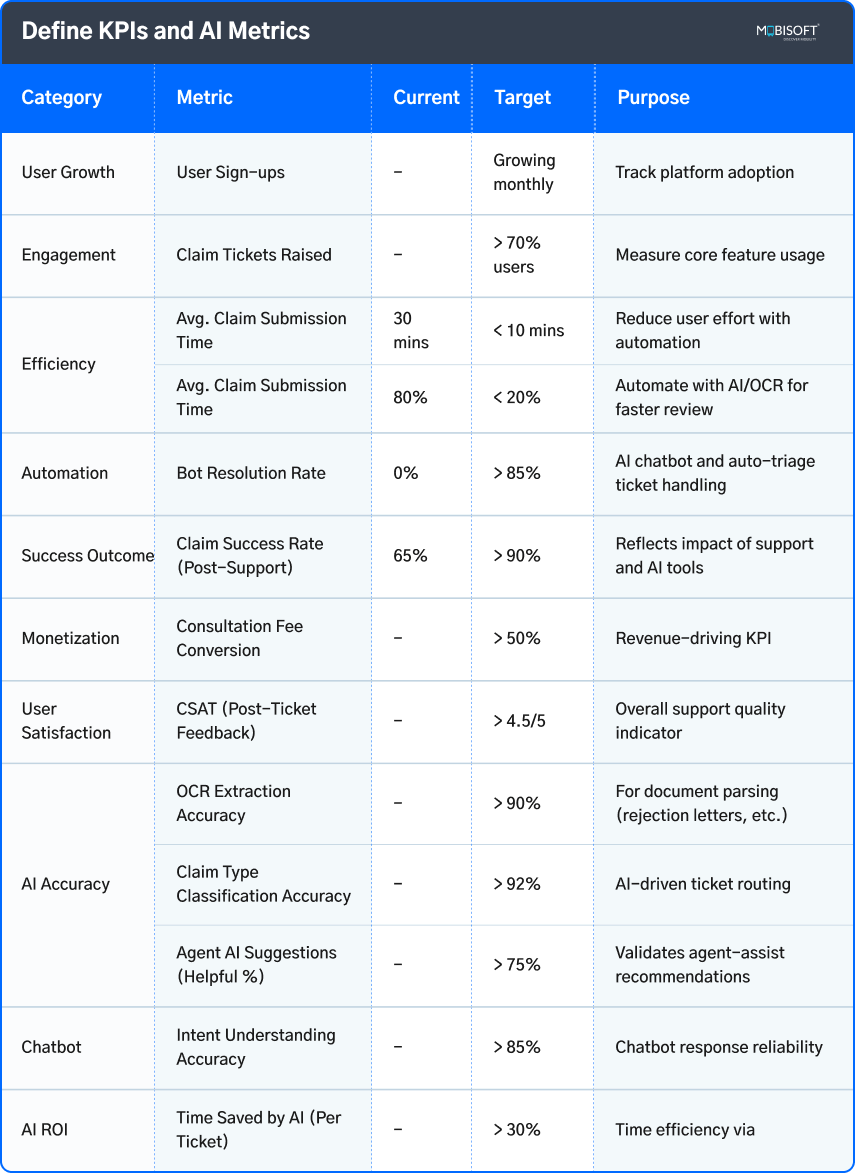
AI Tools:
Use platforms like Amplitude, Mixpanel, or custom dashboards to monitor key KPIs (key performance indicators), trained on user events.
Use the following prompt to generate KPIs and AI Metrics
Generate a comprehensive list of Key Performance Indicators (KPIs) with AI-specific metrics relevant to evaluating the performance, efficiency, and accuracy of an AI-driven system. Categorize them into business KPIs and AI/technical metrics.
Step 6: Build with AI-Integrated Tools
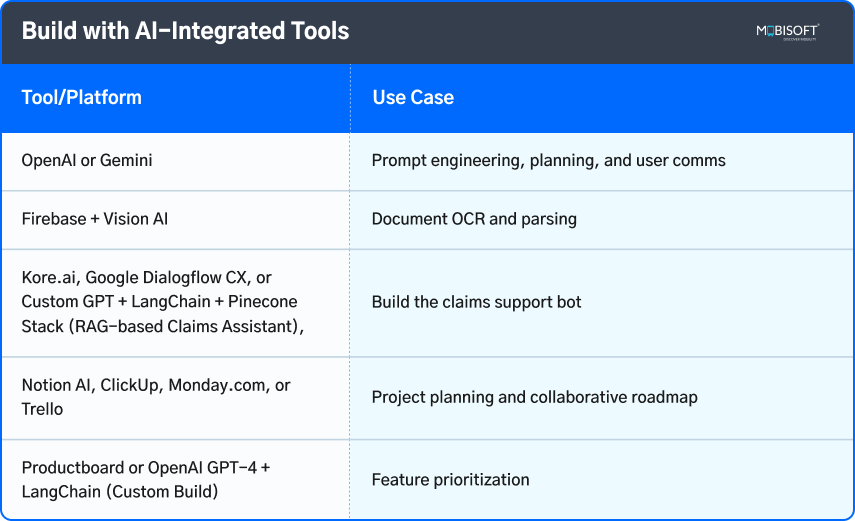
A roadmap becomes even stronger when combined with DevOps services that enable faster releases and continuous improvements.
Download the Free Roadmap Template
Here’s a product roadmap template for startups in insurance-tech (or any digital product with AI). It includes:
This includes:
- MVP Roadmap: Sprint-wise breakdown with features, AI integration, and owner.
- Post-MVP Backlog: Optional enhancements with benefits.
Click to Download Product Roadmap Template
AI Prompt Examples for Startup Founders
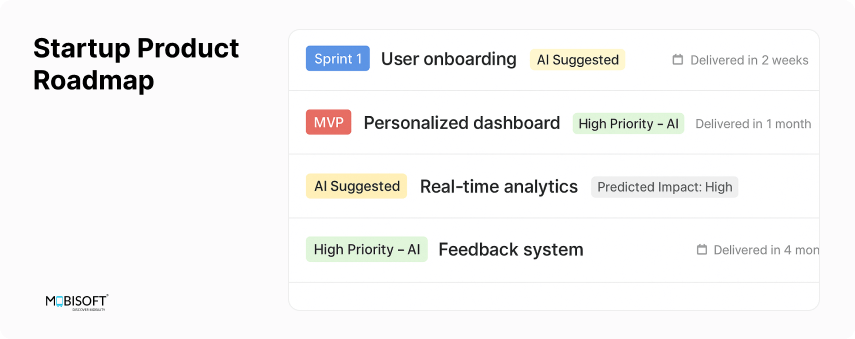
Ideation & Validation
- “Generate 10 innovative product ideas that solve [specific pain points] in [industry]. Rank them by market demand and differentiation potential.”
- “Compare the top 3 competitor products in [industry]. Identify gaps, weaknesses, and opportunities for disruption.”
- “Create a customer persona profile for my target audience [describe briefly]. Suggest key problems they face and solutions they value most.”
- “Evaluate the feasibility of launching a [product/service] in [market/region]. List potential barriers and enablers.”
Strategy Development
- “Draft a 6-month go-to-market strategy for a startup offering [product/service] targeting [audience]. Include marketing channels, KPIs, and budget split.”
- “Outline pricing strategy options (subscription, freemium, tiered) for [product/service]. Recommend the best fit and justify.”
- “Suggest 5 strategic partnerships or distribution channels for scaling [product/service] in [region/market].”
- “Generate a SWOT analysis for my startup idea in [industry]. Include emerging AI/tech trends that could influence it.”
Scaling & Roadmap
- “Propose a phased product roadmap for [startup/product] over the next 12 months. Break into MVP, growth, and scaling stages with milestones.”
- “Identify the top operational bottlenecks startups face when scaling from 100 to 1,000 customers. Suggest AI-driven solutions to overcome them.”
- “Outline a hiring roadmap for a startup growing from 5 to 50 employees. Specify priority roles, timing, and cost impact.”
- “Design an investor pitch outline highlighting traction, growth strategy, and future scaling opportunities for ‘startup’.”
Prompt
Generate a concise list of high-impact AI prompt examples tailored for startup founders. The prompts should specifically help them with ideation, strategy development, and scaling decisions in relation to their product or business roadmap.
Founders can further enhance outcomes with tailored startup IT solutions designed for scalability and cost-efficiency.
Final Thoughts
Creating a startup product roadmap is about turning vision into execution. With AI product roadmap tools, early-stage startups can accelerate delivery, cut costs, and enhance user experience.
For startups seeking inspiration, here’s a detailed Roadmap to build an App Like Uber that showcases how vision can turn into reality.
For insurance-tech, the opportunity is even greater: skip legacy systems and adopt smarter, faster, AI-driven product roadmap strategies to stay competitive.





 August 29, 2025
August 29, 2025


